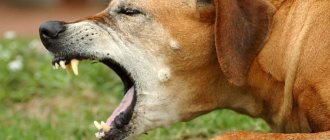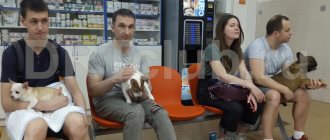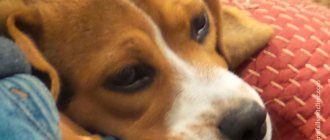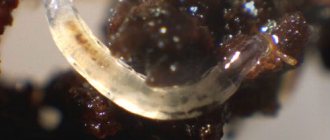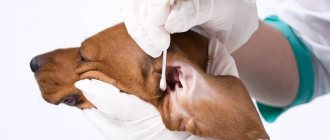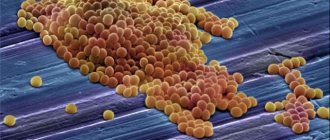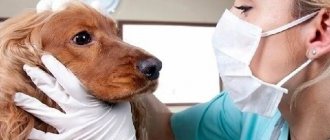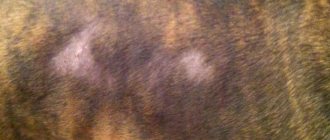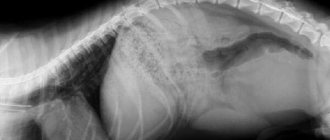Home » Useful Information
Aviary (kennel) cough, or laryngotracheobronchitis, is an infectious disease that develops in pets due to damage to the upper respiratory tract. Owners of four-legged pets should familiarize themselves with information about what constitutes kennel cough in dogs, its symptoms and treatment at home, as well as the causes, preventive methods, and possible consequences of this disease.
- 2 Causes of the disease
- 3 Symptoms
- 4 Treatment
4.1 Use of drugs
Description of the disease
Veterinarians also call infectious laryngotracheobronchitis, or kennel cough, canine influenza and adenovirus. It is called aviary because in places where pets live in large numbers it spreads almost at lightning speed, affecting all the inhabitants of the nursery.
The disease develops when pathogenic microorganisms enter the dog’s body. Dogs with strong immunity tolerate this disease quite easily and often recover on their own. But puppies and weakened dogs can develop serious complications if not treated promptly.
Possible complications of infectious laryngotracheitis
The most common complication of infectious laryngotracheitis is the addition of a bacterial component to the viral infection of the upper respiratory tract, which usually begins with kennel cough. Typically, microbes living in a dog’s body do not cause it any particular trouble, and their number is maintained at a safe level by the general immune system. But at the moment when all the protective forces are mobilized to fight the strongest pathogen, which is the virus, an extremely favorable environment arises for microbes, protozoa and other parasites and they begin to multiply uncontrollably.
The mucus that accumulates in the animal’s nose and bronchi helps to speed up this process, especially if, due to a lack of fluid in the body, the consistency of the exudate becomes more viscous or, even worse, it dries out and turns into a crust, clogging the respiratory tract and creating real resort conditions for pathogenic microflora. Bacteria that develop due to inadequate treatment of infectious laryngotracheitis can cause severe forms of otitis, bronchitis or pneumonia, and the dog can actually die from these diseases, especially if the process is left uncontrolled and antibiotics are not used.
Another specific complication that can occur in a dog not due to a general weakening of the body by the virus, but precisely due to spasmodic muscle contraction during a strong dry cough, is prolapse (sagging) or collapse (blocking) of the trachea.
In order to understand the essence of this phenomenon, you need to remember the school anatomy course. The trachea in a dog (as in a person) is a tube consisting of cartilaginous half-rings, between which there is connective tissue - the tracheal membrane. If the tracheal cartilages lose their firmness and elasticity (for example, due to age-related changes), they begin to gradually sag. In this condition, aggravated by coughing attacks, involuntary movements of the membrane can block the lumen of the trachea and the animal begins to choke.
Find out what heart cough is in dogs, why it occurs and how to treat it.
Causes of the disease
The causative agent of aviary cough is parainfluenza virus, adenovirus or canine distemper. These microorganisms are transmitted from a sick animal to a healthy animal by airborne droplets. When microbes enter the pet’s body, they settle on the mucous membrane of the respiratory tract and, as they multiply, infect the membrane cells.
This infection spreads most often in confined spaces. A dog can become infected at an exhibition or in a kennel, through contact with a sick dog. Microorganisms multiply at different rates, and the first symptoms of the disease appear within a week, less often - after 10-20 days.
Treating dogs at home
Only after making a clear diagnosis based on the clinical picture and test results, the doctor will prescribe treatment. Self-medication can only worsen the animal’s well-being.
If the pet’s condition has not progressed to a severe phase and there are no additional complications, then treatment can be done at home.
The treatment regimen is developed strictly individually and looks approximately as follows:
- During treatment, the animal must remain calm. It is necessary to limit his physical activity;
- It is important to isolate your four-legged friend from other dogs;
- The food includes quality products, but in limited quantities;
- Etiotropic, symptomatic and pathogenetic therapies are possible
- Taking medications to restore the immune system, for example Vegetan, Lykopid, etc.;
- If the causative agent of the disease is identified, immunoglobulins or antibiotics are additionally prescribed, for example, Kanamycin, Tetracycline, etc.;
- The use of folk remedies is recommended only with the permission of a veterinarian;
- For 1-2 months, you will need to introduce a vitamin-mineral complex into complementary foods.
Signs of a dog's recovery are considered to be improved health, appetite, and energy. There should be no cough for two days. With proper care and following all recommendations, recovery occurs within 1-2 weeks.
Prevention measures
Dog owners understand that it is impossible to completely protect their pet from communication with other four-legged animals. Therefore, vaccination will help to develop strong immunity. Unfortunately, since infectious tracheobronchitis is a whole complex of respiratory diseases, a single vaccine does not yet exist. Specialists use drugs to build immunity and protect the body from various viruses.
The first vaccination should be given to puppies up to 3 months of age. Repeated vaccination after six months and then annually.
In addition to the required vaccinations, the following preventive measures are recommended:
- Periodic intake of medications containing vitamins and minerals
- Proper nutrition and care
- Insulating short-haired dogs in cold and wet weather to avoid hypothermia
- Avoiding contact with sick and stray animals
- Timely treatment of your pet for parasites
- Enclosures require dry indoor conditions and a good ventilation system.
- Regular disinfection of the dog’s habitat
In addition to all of the above, it is very important to regularly show the animal to the doctor. This is especially true for dogs that live in crowded conditions.
Symptoms
The main symptom is a dry cough. It is often accompanied by vomiting. Attacks can be severe and occur most often after eating food and water.
The following signs indicate the development of canine influenza:
- refusal of food;
- lethargy;
- increased body temperature;
- sputum discharge;
- serous discharge from the eyes and nose;
- swollen lymph nodes;
- disruptions in intestinal function.
The above symptoms are not typical for canine influenza, and their presence may indicate other diseases. For this reason, it is not recommended to use any medications on your own to eliminate signs of the disease, as this will lead to a worsening of the condition of your four-legged pet.
The main signs in the presence of a secondary bacterial infection include symptoms such as fever and purulent bronchitis.
The main symptoms of tracheobronchitis
It also happens that the dog owner does not notice that the pet is already sick. The fact is that tracheobronchitis is practically asymptomatic. The appetite does not disappear, and the animal looks healthy.
The main indicator of the disease is an uncontrolled dry cough. It occurs due to dry airways. The cough gets worse if you touch the dog in the neck or jaw area.
The incubation period of the disease lasts from 4 days to several weeks. It all depends on the pathogen and the form of the disease:
- Acute form, the disease manifests itself within several days;
- Under acute, the disease progresses slowly and serious complications are possible.
Experts include the following signs as the main symptoms of aviary cough:
- Frequent, convulsive cough without sputum;
- Labored breathing;
- A sharp jump in temperature to 39-40 degrees at the initial stage;
- Copious nasal discharge;
- Tonsillitis;
- Diarrhea or vomiting may occur.
Without proper treatment of a dog with a subacute phase, the case can end in death
Diagnosis of the disease
Making the correct diagnosis is already half the success . It is best to consult a veterinarian for this procedure. After all, diagnosing the disease on your own is very difficult. Due to the lack of pronounced symptoms, it is easily confused with similar diseases. For example, due to inflammation of the tonsils, tracheobronchitis is similar in its symptoms to ordinary sore throat, and the symptoms of nausea and vomiting are confused with the plague.
That is why the doctor tries to use detailed data for diagnosis:
- Examination of the animal;
- Studying the history of vaccination;
- Blood and urine tests;
- Hematological studies;
- X-ray, to rule out other potential causes;
- Bronchoscopy in severe cases.
Of course, the selection of diagnostic procedures largely depends on the condition and severity of the disease. Also, it should be taken into account that tracheobronchitis can have several pathogens at once. Thus, the clinical picture is influenced by several factors:
- Age, weight and breed of the dog;
- Availability of vaccinations;
- General health of the patient;
- State of immunity.
Treatment
Treatment of aviary cough is carried out at home after confirmation of the diagnosis by a veterinarian. At the clinic, a specialist prescribes medications for the pet. Owners need to follow the recommendations of the veterinarian and provide comfortable conditions for their four-legged pet.
To speed up the healing process, inhalations are recommended. Moist steam helps thin mucus and reduce swelling of the respiratory tract. The sick dog must be taken into the bathroom, in which the hot water tap must first be opened, and removed from there after 5-7 minutes. During the procedure, the dog should not be left unattended for a longer period, as this will lead to a burn to the mucous membrane.
It is advisable to keep your pet in a dry, warm room with an optimal level of humidity and good ventilation. The dog should also be given plenty of fluids. It is necessary to give the dog warm boiled water and milk. Until complete recovery, a sick dog should be protected from contact with other animals and stressful situations.
Use of drugs
Drug treatment of kennel cough in dogs can be complex and is carried out using the following drugs:
- antibacterial (suppress secondary infection and prevent the development of complications);
- immunostimulants (activate the protective functions of the pet’s body);
- expectorants (accelerate the discharge of sputum);
- vitamin complexes (promote rapid recovery of the animal).
Most often, experts recommend using the following tablets for kennel cough in dogs:
| Name | Description of the drug | Image |
| Tsiprolet | Broad-spectrum antibacterial agent. The active substance in it is ciprofloxacin | |
| Mukaltin | Herbal tablets based on marshmallow root. Helps thin mucus and quickly remove phlegm | |
| Sinulox | An antibiotic is prescribed for a severe cough. The active substance in it is amoxicillin | |
| Polydex Immunity Up | Vitamin complex that helps improve the dog’s immunity and speed up recovery |
The dosage and duration of taking a particular drug is determined by a veterinarian.
Aviary cough in dogs - diagnosis of the disease
Diagnosis of bordetellosis presents certain difficulties. This is due to the similarity of clinical symptoms with other infections. It is recommended to isolate bacteria from nasal and throat washes.
Next, the samples must be sent to the laboratory. For the transport of biological material, special coal-dust media are used. Coal-dust cephalexin agar is used for inoculating bacterial cultures. To make a final diagnosis, cytological and bacteriological analysis is performed. High efficiency is characteristic of the polymerase chain reaction (PCR). This method facilitates quick and correct diagnosis of the disease. It is based on the study of the DNA structure of a microorganism.
Bordetelliosis in dogs must be distinguished from some forms of plague, nonspecific tonsillitis and tracheobronchitis.
Possible consequences
The most severe complication of infectious laryngotracheobronchitis is pneumonia. It develops in the absence of timely treatment for kennel cough, most often in puppies, older dogs and dogs with weak immune systems. Advanced pneumonia, in turn, leads to the death of the animal and to a significant lag in the development and growth of young individuals.
The disease is often complicated by conjunctivitis, anorexia and pharyngitis. Pets also develop small hemorrhages on the skin in the neck area. Against the background of weakened immunity, a secondary bacterial infection can also develop.
Complete recovery from infectious laryngotracheobronchitis does not provide long-term immunity to this disease. Kennel cough can develop again if preventive measures are ignored.
Incubation period for kennel cough
Due to the fact that the disease is transmitted by airborne droplets, the likelihood of infection of surrounding animals is unusually high. The lack of timely diagnosis and treatment leads to massive damage to animals and, in some cases, their death in the event of a secondary infection.
The first symptoms of parainfluenza in dogs can appear either after 3-5 or 21-30 days of the incubation period. It all depends on the animal’s immunity, as well as on the quality of food and living conditions.
The canine parainfluenza virus affects the body of weakened, exhausted animals, as well as individuals in a stressful situation (moving, changing ownership or visiting exhibitions).
Establishing a diagnosis
The initial diagnosis can be carried out by the owner himself. If the owner suspects his pet has kennel cough, he should monitor whether its character changes after eating and eating. If it becomes more frequent and stronger, then we may be talking about kennel cough.
The veterinary clinic conducts a general examination. After which the doctor collects anamnesis and examines the vaccination passport. After clarifying the diagnosis, therapy is prescribed.
The diagnosis is clarified in a veterinary clinic.
About prevention
The only reliable preventive measure is timely vaccination of animals against the diseases that we indicated above. The vaccine will help, if not prevent, then at least weaken the course of the disease. The animal is vaccinated for the first time at the age of six weeks, and then repeated every three weeks until the dog reaches the age of 14-16 weeks.
Revaccination should be performed every year. If the risk of developing the disease is very high (massive cases have been reported in your region), it is advisable to limit your walking time as much as possible or arrange a quarantine. Active immunization with polyvalent immune sera is also possible, especially if the dog was vaccinated at the wrong time or not with all vaccines. High-quality feeding and good living conditions in many cases help to avoid disease.
How to prevent it from happening
There is only one reliable way to protect your dog from the disease - timely vaccination and subsequent revaccinations at the recommended age. Even if the infection takes on a new form, the vaccine will make the disease easier. Vaccination against canine influenza is recommended annually.
In addition, it is better to avoid crowded areas where dogs can come into close contact with each other, especially if cases of infection have already appeared in your area. And, of course, the pet needs optimal living conditions and proper care. And also your love and care.
Recommended Posts
Why does a dog cough and how to treat it?
Main symptoms and treatment options for leptospirosis in dogs
The main causes and treatment options for urinary incontinence in dogs
The main causes and treatment options for seizures in dogs
The main types of pneumonia in dogs and how to treat them
Symptoms and treatment options for arthritis and related joint diseases in dogs
Preventive actions
For prevention, contact between your pet and infected dogs should be prevented.
An intranasal vaccine contributes to the rapid formation of immunity to the virus in animals . First of all, it is relevant for puppies. It is advisable to vaccinate in a timely manner. The maximum effect is achieved 4–5 days after the procedure.
1 vaccination must be intranasal. The next 2 times the medicine is administered subcutaneously.
After this, the dog needs to be vaccinated every 12 months. This helps maintain the required level of immunity.
It is also important to prevent your dog from coming into contact with infected animals.
How to feed the dog?
Don't restrict your pets' water intake, but never force feed them. During treatment, alternate warm boiled water with milk. Add a little honey to your drink to relieve pain in the larynx.
Warm milk with honey restores strength and makes you feel better when your dog is coughing. Honey is prohibited for dogs with diabetes or allergies.
Until complete recovery, the pet will eat poorly or refuse to eat at all. Force feeding will only lead to vomiting and stress, which is completely inappropriate for a sick four-legged dog.
Prevention and vaccination method
Vaccination against influenza is an effective means of preventing the disease. It is recommended to vaccinate in September or October. WHO recommends this annually for people at risk and workers in certain professions. These categories include pregnant women, children from 6 months to 5 years, elderly people and people with chronic diseases, medical workers, teachers, educators, sellers, etc. A flu vaccination allows the development of antibodies in the blood within 7-14 days. The immune system will resist virus attacks for about 6 months. Follow the rules of hygiene, wash your hands often, avoid people who have a cold, and spend less time in crowded places - this is the best flu prevention for everyone.
